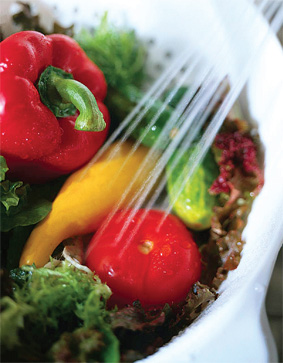
THE Codex Alimentarius Commission, jointly established in 1963 by the Food and Agriculture Organisation of the United Nations (FAO) and WHO, develops international food standards that protect the health of consumers and ensure fair trade practices in the food trade. The CAC has 182 member states, including those in MENA, and one member organisation, the European Community - membership now represents 99% of the world's population. The results of its work form the Codex Alimentarius (Latin for "food code"), a set of international food safety and quality standards. These standards, when introduced in national legislation, contribute to the safety of foods and to international food trade. Most recently, in July 2010, international experts set limits on melamine levels in food and aflatoxins in Brazil nuts, and established guidance for hygienic measures for safer fresh salads and seafood. The 33rd Session of Codex Alimentarius Commission in Geneva, attended by 500 delegates from about 130 countries, saw greater participation of more developing countries - reflecting the global awareness of food safety issue and the impact of Codex. Melamine in powdered infant formulae. This new guidance sets the maximum amount of melamine allowed in powdered infant formulae is 1 mg/kg and the amount of the chemical allowed in other foods and animal feed is 2.5 mg/kg. Traces of melamine, a chemical used in a variety of industrial processes, unavoidably get into food by contact without causing health problems; however the substance is toxic at high levels. While not legally binding the new levels allow countries to refuse to allow the importation of products with excessive levels of melamine. "Establishment of maximum levels will help governments differentiate between low levels of unavoidable melamine occurrence that do not cause health problems, and deliberate adulteration - thereby protecting public health without unnecessary impediments to international trade" said Martijn Weijtens, chair of the Codex Committee on contaminants in foods. Hygienic measures for fresh salads and seafood. The new Codex measures provide specific guidance for production, harvesting, packing, processing, storage, distribution, marketing and consumer education to reduce food safety risks, such as contamination with pathogens like Salmonella, E. coli, and Hepatitis A virus, associated with these products. Guidance covers such aspects as the control of irrigation waters, cooling and storage and correct washing of hands by consumers.

The Commission also gave specific advice on how to control bacteria in seafood throughout the food chain, as there has been an increase in reported outbreaks of foodborne disease caused by bacterial species called Vibrio, which are typically associated with the consumption of seafood. Aflatoxin. For aflatoxins in Brazil nuts maximum levels of 10 micrograms/kg were set for shelled and ready-to-eat nuts, and 15 micrograms/kg for shelled Brazil nuts (intended for further processing); the Commission also adopted a code of practice to prevent this contamination. Aflatoxins are carcinogenic fungal toxins that can contaminate corn, peanuts and other food crops such as tree nuts under certain conditions. Codex guidelines from 2009 In mid-2009, the CAC adopted more than 30 food safety standards and guidelines to improve worldwide food safety and protect the health of consumers. Reduction of acrylamide in food. The chemical acrylamide, first identified in food in 2002, is produced during frying, roasting and baking of carbohydrate-rich food such as French fries, potato crisps, coffee, biscuits, pastries and breads. Acrylamide is considered a possible human carcinogen. The code of practice will provide national and local authorities, manufacturers and others with guidance to prevent and reduce formatio
Кроссовки Lifestyle THE Codex Alimentarius Commission, jointly established in 1963 by the Food and Agriculture Organisation of the United Nations (FAO) and WHO, develops international food standards that protect the health of consumers and ensure fair trade practices in the food trade. The CAC has 182 member states, including those in MENA, and one member organisation, the European Community - membership now represents 99% of the world's population. The results of its work form the Codex Alimentarius (Latin for "food code"), a set of international food safety and quality standards. These standards, when introduced in national legislation, contribute to the safety of foods and to international food trade. Most recently, in July 2010, international experts set limits on melamine levels in food and aflatoxins in Brazil nuts, and established guidance for hygienic measures for safer fresh salads and seafood. The 33rd Session of Codex Alimentarius Commission in Geneva, attended by 500 delegates from about 130 countries, saw greater participation of more developing countries - reflecting the global awareness of food safety issue and the impact of Codex. Melamine in powdered infant formulae. This new guidance sets the maximum amount of melamine allowed in powdered infant formulae is 1 mg/kg and the amount of the chemical allowed in other foods and animal feed is 2.5 mg/kg. Traces of melamine, a chemical used in a variety of industrial processes, unavoidably get into food by contact without causing health problems; however the substance is toxic at high levels. While not legally binding the new levels allow countries to refuse to allow the importation of products with excessive levels of melamine. "Establishment of maximum levels will help governments differentiate between low levels of unavoidable melamine occurrence that do not cause health problems, and deliberate adulteration - thereby protecting public health without unnecessary impediments to international trade" said Martijn Weijtens, chair of the Codex Committee on contaminants in foods. Hygienic measures for fresh salads and seafood. The new Codex measures provide specific guidance for production, harvesting, packing, processing, storage, distribution, marketing and consumer education to reduce food safety risks, such as contamination with pathogens like Salmonella, E. coli, and Hepatitis A virus, associated with these products. Guidance covers such aspects as the control of irrigation waters, cooling and storage and correct washing of hands by consumers.
THE Codex Alimentarius Commission, jointly established in 1963 by the Food and Agriculture Organisation of the United Nations (FAO) and WHO, develops international food standards that protect the health of consumers and ensure fair trade practices in the food trade. The CAC has 182 member states, including those in MENA, and one member organisation, the European Community - membership now represents 99% of the world's population. The results of its work form the Codex Alimentarius (Latin for "food code"), a set of international food safety and quality standards. These standards, when introduced in national legislation, contribute to the safety of foods and to international food trade. Most recently, in July 2010, international experts set limits on melamine levels in food and aflatoxins in Brazil nuts, and established guidance for hygienic measures for safer fresh salads and seafood. The 33rd Session of Codex Alimentarius Commission in Geneva, attended by 500 delegates from about 130 countries, saw greater participation of more developing countries - reflecting the global awareness of food safety issue and the impact of Codex. Melamine in powdered infant formulae. This new guidance sets the maximum amount of melamine allowed in powdered infant formulae is 1 mg/kg and the amount of the chemical allowed in other foods and animal feed is 2.5 mg/kg. Traces of melamine, a chemical used in a variety of industrial processes, unavoidably get into food by contact without causing health problems; however the substance is toxic at high levels. While not legally binding the new levels allow countries to refuse to allow the importation of products with excessive levels of melamine. "Establishment of maximum levels will help governments differentiate between low levels of unavoidable melamine occurrence that do not cause health problems, and deliberate adulteration - thereby protecting public health without unnecessary impediments to international trade" said Martijn Weijtens, chair of the Codex Committee on contaminants in foods. Hygienic measures for fresh salads and seafood. The new Codex measures provide specific guidance for production, harvesting, packing, processing, storage, distribution, marketing and consumer education to reduce food safety risks, such as contamination with pathogens like Salmonella, E. coli, and Hepatitis A virus, associated with these products. Guidance covers such aspects as the control of irrigation waters, cooling and storage and correct washing of hands by consumers.  The Commission also gave specific advice on how to control bacteria in seafood throughout the food chain, as there has been an increase in reported outbreaks of foodborne disease caused by bacterial species called Vibrio, which are typically associated with the consumption of seafood. Aflatoxin. For aflatoxins in Brazil nuts maximum levels of 10 micrograms/kg were set for shelled and ready-to-eat nuts, and 15 micrograms/kg for shelled Brazil nuts (intended for further processing); the Commission also adopted a code of practice to prevent this contamination. Aflatoxins are carcinogenic fungal toxins that can contaminate corn, peanuts and other food crops such as tree nuts under certain conditions. Codex guidelines from 2009 In mid-2009, the CAC adopted more than 30 food safety standards and guidelines to improve worldwide food safety and protect the health of consumers. Reduction of acrylamide in food. The chemical acrylamide, first identified in food in 2002, is produced during frying, roasting and baking of carbohydrate-rich food such as French fries, potato crisps, coffee, biscuits, pastries and breads. Acrylamide is considered a possible human carcinogen. The code of practice will provide national and local authorities, manufacturers and others with guidance to prevent and reduce formatioКроссовки Lifestyle
The Commission also gave specific advice on how to control bacteria in seafood throughout the food chain, as there has been an increase in reported outbreaks of foodborne disease caused by bacterial species called Vibrio, which are typically associated with the consumption of seafood. Aflatoxin. For aflatoxins in Brazil nuts maximum levels of 10 micrograms/kg were set for shelled and ready-to-eat nuts, and 15 micrograms/kg for shelled Brazil nuts (intended for further processing); the Commission also adopted a code of practice to prevent this contamination. Aflatoxins are carcinogenic fungal toxins that can contaminate corn, peanuts and other food crops such as tree nuts under certain conditions. Codex guidelines from 2009 In mid-2009, the CAC adopted more than 30 food safety standards and guidelines to improve worldwide food safety and protect the health of consumers. Reduction of acrylamide in food. The chemical acrylamide, first identified in food in 2002, is produced during frying, roasting and baking of carbohydrate-rich food such as French fries, potato crisps, coffee, biscuits, pastries and breads. Acrylamide is considered a possible human carcinogen. The code of practice will provide national and local authorities, manufacturers and others with guidance to prevent and reduce formatioКроссовки Lifestyle
 iConnectHub
iConnectHub
 Login/Register
Login/Register Supplier Login
Supplier Login


























